
They Don’t Want Your Genes in the Pool: A Brief History of Eugenics
by James Corbett
The Corbett Report
January 16, 2016
The ancient Egyptians worshipped the Pharaohs as progeny of the sun god, Ra. The Japanese were told that their Imperial family descended from the sun goddess, Amaterasu, and the sea god, Ryuujin. In Europe, monarchs claimed that God Himself had directly granted them a “Divine Right” to rule over their subjects. In China they called it the “Mandate of Heaven.”
For as long as there have been royalty there have been elaborate theological justifications for why monarchs deserve to rule over the people . . . and there has always been royalty.
It’s easy to see why the ruling class has tried to foster this idea of godly rule in culture after culture. After all, if the Kings and Queens and Emperors and Pharaohs were not gods, or at least chosen by God, why would anyone listen to them? The difference between a regal king and a tinpot dictator disappears if the king’s divinity is denied.
Even today, in this ‘post-monarchical’ era, ancient superstitions about royal families persist. They are still referred to as “blue bloods” as if the very blood that flowed through their veins is different from yours or mine. There is still an elaborate etiquette for meeting the Queen of England, and it is still strictly enforced without exception. Even Obama had to take a lesson before he could meet with Her Majesty Elizabeth II.
The rituals of class distinction are not merely for show. The royals have always considered themselves of superior stock to the commoners, a breed apart from the poor downtrodden masses who toil in squalor beneath them. Thus the obsession with breeding that gentry the world over have been at great pains to observe down through the centuries. Or should that be “inbreeding”? Certainly the branches of many a royal family tree fold in as much as they branch out, explaining the remarkable physical similarity between members of the European royal families or the recessive disorders like haemophilia that have plagued European royalty for centuries.
Modern DNA analysis has shown that the Spanish branch of the Hapsburg family, the dynasty that ruled over vast swathes of Europe for over 500 years, was inbred out of existence. After generations of cousins marrying cousins and uncles marrying nieces, the genetic variation between Hapsburg husbands and wives was no greater than that between brothers and sisters. The last member of the Spanish Hapsburgs, Charles II, died a congenitally sick, deformed man, physically unable to have a child in order to carry on the dynasty. Nor is this a modern phenomenon: recent DNA analysis of Egyptian Pharaoh Tutankhamen shows that he, too, was the sickly, deformed product of a brother-sister incestuous pairing.
The royal fixation with inbreeding arose—as do many such ideas—from seemingly irrefutable empirical observation. Animal breeding has been practiced for thousands of years. The ability to breed certain traits into or out of pets and livestock has been an art form ever since humans began domesticating animals to work the land. It wasn’t much of a stretch for rulers and sovereigns to toy with the idea of using these techniques to purify their own stock and domesticate their own “chattel,” the commoners.
The animal breeding/human breeding analogy is drawn in some of the most ancient texts on the subject. In the 6th century B.C., the Greek poet Theognis of Megara lamented his society’s unwillingness to show the same attention to the breeding of men and women that they showed to the breeding of rams and horses:
“With kine and horses, Kurnus! we proceed
By reasonable rules, and choose a breed
For profit and increase, at any price:
Of a sound stock, without defect or vice.
But, in the daily matches that we make,
The price is everything: for money’s sake,
Men marry: women are in marriage given
The churl or ruffian, that in wealth has thriven,
May match his offspring with the proudest race:
That everything is mix’d, noble and base!
If then in outward manner, form, and mind,
You find us degraded, motley, kind,
Wonder no more, my friend! The cause is plain,
And to lament the consequence is vain.”
To the cloistered gentry of the so-called “nobility,” the product of unions between the “nobles” and the “commoners,” has always been viewed as “degraded” and “motley.” The implication is clear: there are inheritable genetic traits that differentiate the social castes. Marrying below one’s position results in a mixture of the nobility’s “good” genes with the commoners “bad” genes.
But, it will be pointed out, that was over two thousand years ago. We no longer live in an age of lords and peasants but an age of unprecedented economic mobility. With the notable exception of the world’s remaining royal families, humanity no longer divides itself into “noble” and “base” castes. We no longer talk in vague generalities about the “mixing” of traits between parents, but with precise scientific understanding of the functioning of genes and chromosomes and the structure of DNA and the importance of upbringing and environment in shaping who we are. We no longer believe (assuming we ever did) that a Queen Elizabeth or a King Abdullah or an Emperor Akihito has been chosen by God to rule over us.
No, ours is an “enlightened” era: Our leaders are democratically elected politicians, not hereditary monarchs. Upward mobility is a function of drive, motivation and talent, not peerage and good breeding. Celebrities are our royalty. The richest men and women in the world are average Joes and Janes who pulled themselves up by their bootstraps, and they are all ranked in order of wealth by glossy magazines each year . . .
. . . Or so the story goes. The truth, as always, is not quite in keeping with popular perception.
As it turns out, there is a modern-day royalty—hereditary lines of rulers in positions of power who possess nearly unthinkable wealth. These kings and queens, however, do not live in castles or demand deference. Their faces are not printed on our bills or stamped into our coins (although their signatures may be on the bills, for those who care to look). These are the inconspicuous monarchs, notable for the buildings and banks, financial institutions and tax-free foundations that bear their family names. They have traded crowns and scepters for shirts and ties, these lords of business and finance who blend into crowds. And we can trace their rise to the fall of the monarchies of old.
By the late 17th century, with the world already transitioning away from medieval feudalism and towards modern capitalism, the absolute power of the European monarchs was being whittled away. In England, the Glorious Revolution of 1688 and the Bill of Rights of 1689 brought an end to the concept of the total authority of the king, an authority that had itself been formally limited by the Magna Carta in 1215. In 1694 the establishment of the Bank of England set a precedent for private control of a nation’s money supply, a template that was copied in country after country (including, of course, the United States) in the coming centuries. Before long it was a handful of banking families that controlled the exchequers of the governments that they “served” and the overt royalty of old was replaced with a new, covert royalty.
The would-be rulers of the world traded the trappings of royalty and the prestige of the throne for the modern-day suits and ties and corporate head offices from which our own society is directed and controlled. Their ranks were soon swelled by another type of nouveau riche: the cutthroat monopolists of the 19th century who built empires out of steel, rail and oil.
This new royalty, like the royalty of old, is obsessed with breeding. Rockefellers marry Carnegies, Averells marry Harrimans, Walkers marry Bushes, Foresters marry Rothschilds (and then honeymoon at the White House) until the dynastic family lines are ensconced in a modern-day aristocracy every bit as inter-bred and elitist as the lords and ladies of bygone days.
Unlike royalty of old, however, this modern breed of tyrant cannot rely on the old canard of “divine right” to justify their positions of power. With the fall of the medieval world came the rise of a new age of empiricism, itself a total revolution in humanity’s understanding of the world and our place in it. The rulers of our scientific age needed a scientific-sounding gloss to update the “divine right” of old and preserve the right of the few to rule the many. Luckily for this new breed of monarch, a pseudoscientific gloss was not long in coming.
In 1859 Charles Darwin published On the Origin of Species by Means of Natural Selection, or the Preservation of Favoured Races in the Struggle for Life. Within ten years, his cousin, Francis Galton, had published Hereditary Genius, his first attempt to outline a theory in which character traits such as intellect and virtuousness are inheritable. Essentially, Galton was positing that humans can be bred for intelligence or industriousness just as a dog can be bred to be aggressive or a horse can be bred for racing. In 1883 Galton coined the term “eugenics”—from the Greek eu (good) and -genēs (born)—to describe the study of how human evolution could be directed to improve “the racial quality of future generations.” The very name eugenics itself betrays the underlying assumption of this self-serving ideology: that there are “good” genes and “bad” genes that make individuals and their offspring more or less likely to survive in the societal struggle for existence.
Given this fairly innocuous-sounding assumption, the erstwhile eugenicist comes rather quickly to a number of startling conclusions. One of these is that those who are poor, disabled, or otherwise impaired are in fact merely the products of bad breeding. Motivated only by the desire to encourage the continual improvement of the human gene pool, the eugenicists neither pity nor scorn these individuals for their natural inabilities. Instead they seek to ensure that the poor and the weak produce as few offspring as possible while the wealthy elite have as many children as possible.(Với giả định nghe có vẻ vô thưởng vô phạt này, nhà ưu sinh học đầu tiên đưa ra một số kết luận đáng kinh ngạc khá nhanh chóng. Một trong số đó là những người nghèo, tàn tật, hoặc khiếm khuyết thực chất chỉ là sản phẩm của quá trình gây giống sinh sản tồi kém. Chỉ vì được thúc đẩy bởi mong muốn khuyến khích sự cải thiện liên tục của nguồn gen con người, những người theo thuyết ưu sinh không thương hại hay khinh miệt những cá nhân này vì những khả năng tự nhiên của họ. Thay vào đó, họ tìm cách đảm bảo rằng người nghèo và người yếu sinh ra càng ít con càng tốt trong khi tầng lớp giàu có càng có nhiều con càng tốt.)
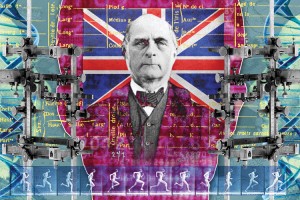 You
might want to read that last sentence again to see if you have
understood what it is saying. Without understanding this point, the
prime motivation of the eugenics movement, all else will be difficult to
comprehend. (Có thể bạn muốn đọc lại câu cuối cùng đó một lần nữa để xem liệu bạn đã hiểu nó đang nói gì chưa. Nếu không hiểu điểm này, động lực chính của phong trào ưu sinh, tất cả những thứ khác sẽ khó hiểu.)
You
might want to read that last sentence again to see if you have
understood what it is saying. Without understanding this point, the
prime motivation of the eugenics movement, all else will be difficult to
comprehend. (Có thể bạn muốn đọc lại câu cuối cùng đó một lần nữa để xem liệu bạn đã hiểu nó đang nói gì chưa. Nếu không hiểu điểm này, động lực chính của phong trào ưu sinh, tất cả những thứ khác sẽ khó hiểu.)
Another startling corollary of the “good” gene/“bad” gene hypothesis is that those groups of individuals that can dominate others (militarily, economically or otherwise) not only have the right to exercise that power but in fact are obliged to do so in the interest of improving the species. In short, might makes right. If you’re not inbred with us, you’re against us.
It is not hard to understand why eugenics appealed so much to the rich and privileged gentlemen scientists of the British upper class or the American robber barons who would go on to fund their research. Here was the exact thing that the modern-day royalty needed: a founding mythology that provided a justification for their wealth and power. Boiled down to its essentials, this mythology stated precisely the same thing as the old mythology of the “divine right” of kings: that the rich and powerful are rich and powerful because they are inherently better than the poor and weak. If this mythology cloaked itself with scientific-sounding arguments instead of appeals to divine authority, then so much the better to capture the spirit of the age. No surprise, then, that it was this new “royalty” that funded the research that began the modern eugenics movement.
The American Eugenics Record Office (and its Cold Springs Harbor laboratory), where the majority of American eugenics research took place, was founded in 1910 by Mary Harriman (of the Bush-Harriman Union Banking crime family) and funded by the Rockefellers and Carnegies. The office held index cards with data on hundreds of thousands of Americans that were to be sorted into “desirable” and “undesirable” traits so that the Carnegie/Rockefeller minions could advocate the removal of people they didn’t like from the gene pool.
Although proponents of eugenics like to refer to the word’s Greek roots as “proof” that the concept is in fact a peaceful quest to breed a better race, the ideology has always been used to advocate the forced segregation, sterilization and ultimately the death of those who the self-appointed “elite” deem unfit to breed. A popular 1918 textbook on “Applied Eugenics” noted that execution was historically the first method of eugenics, adding, that “Its value in keeping up the standard of the race should not be underestimated.” In a chapter on “Lethal Selection,” the book advocated eugenics “through the destruction of the individual by some adverse feature of the environment, such as excessive cold, or bacteria, or by bodily deficiency.”
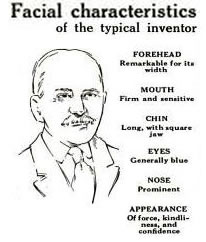 As we now know, eugenics itself was pure quackery. The chief promoter of Darwin’s work in Germany, Ernst Haeckel, also promoted the idea that humanity was a genus, not a species, and that the different races were in fact different species. Cesare Lombroso, a late-19th
century Italian “scientist,” used eugenics as a way to revive the
long-discredited notion of phrenology that the size and shape of body
parts can determine if someone was a “virtuous person” or a “born
criminal.” Of course the inevitable result was that researchers “proved”
the physical characteristics of racial minorities made them more prone
to vice, laziness, criminality and stupidity. Scientists at the Cold
Springs Harbor Laboratory and other “prestigious” institutions wrote
case studies of families that “established” the genetic inheritance of
criminality and mental retardation—studies that were later found to have
been completely fraudulent. With disheartening ease, the “learned scholars” of the day used the cover of eugenics to codify their ingrained prejudices.
As we now know, eugenics itself was pure quackery. The chief promoter of Darwin’s work in Germany, Ernst Haeckel, also promoted the idea that humanity was a genus, not a species, and that the different races were in fact different species. Cesare Lombroso, a late-19th
century Italian “scientist,” used eugenics as a way to revive the
long-discredited notion of phrenology that the size and shape of body
parts can determine if someone was a “virtuous person” or a “born
criminal.” Of course the inevitable result was that researchers “proved”
the physical characteristics of racial minorities made them more prone
to vice, laziness, criminality and stupidity. Scientists at the Cold
Springs Harbor Laboratory and other “prestigious” institutions wrote
case studies of families that “established” the genetic inheritance of
criminality and mental retardation—studies that were later found to have
been completely fraudulent. With disheartening ease, the “learned scholars” of the day used the cover of eugenics to codify their ingrained prejudices.
But using a term like “quackery” to describe eugenics might give the impression that it was a harmless fringe theory, something largely ignored by mainstream science and society at large. In fact, the exact opposite was true, with eugenics being held up both as the paragon of the scientific method and the most fashionable social cause of its day. The eugenicists researched it. Columnists wrote about it. Civic-minded citizens campaigned for it. The idle classes worried about it. Politicians legislated it. This was no fringe theory.
At the turn of the 20th century eugenics remained cloistered in the labs and lecture halls of academia, but steam was already gathering for a mass movement dedicated to “protecting the public” from the scourge of bad breeding. In the U.S., the public was whipped into a fury over the notion that the world was being overwhelmed with the “defective” offspring of criminals, gamblers, alcoholics, wanton women, and, not incidentally, racial minorities and the disabled. State after state began passing laws to allow the government to involuntarily sterilize those most at risk of passing their “defects” on to their children. In this way, society could rest at ease knowing that the gene pool would not be further “polluted” with this genetic “detritus.”
In 1907, the first forced sterilization statute was passed in Indiana. By 1917, twelve states had passed similar legislation. In all, 33 states would go on to pass laws allowing the government to sterilize citizens against their will, and 65,000 individuals would undergo the procedure, many of them black or Native American.
In 1927, the issue of forced sterilization came before the U.S. Supreme Court in the case of Buck v. Bell. The court ruled that the defendant, a woman named Carrie Buck who had been forcibly committed along with her mother for having a child out of wedlock, was “feeble minded” and thus the state was justified in having her sterilized. In the infamous words of Justice Oliver Wendell Holmes, Jr., who wrote the court opinion, “Three generations of imbeciles are enough.” Of course, “feeble mindedness” was not a clinical description of any sort; Buck had had the illegitimate child not as a result of any lasciviousness but because she had been raped by her foster parents’ nephew. The Virginia government now concedes, “Later evidence eventually showed that Buck and many others had no ‘hereditary defects’,” but the case still stood and the Supreme Court upheld that governments had the right to stop their citizens from reproducing.
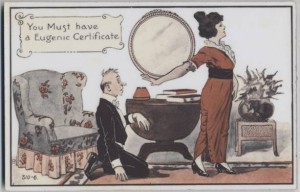 The
leading lights of the “liberal” left at the time, those who are still
considered heroes among progressives, were some of the most passionate
advocates for this eugenics craze, and often due to secretly guarded but
fervently held racist beliefs.
The
leading lights of the “liberal” left at the time, those who are still
considered heroes among progressives, were some of the most passionate
advocates for this eugenics craze, and often due to secretly guarded but
fervently held racist beliefs.
In Britain, famed author and political thinker H. G. Wells (who wrote the draft Declaration of Human Rights for the United Nations) warned against the “ill-trained swarms of inferior citizens” who threatened civilization, including “the black, the brown, the swarthy, the yellow,” as well as Christians and the handicapped. He opined that those who could not survive in his future scientific utopia (especially Africans and Asians) would “have to go.”
Marie Stopes founded an organization called Society for Constructive Birth Control and Racial Progress, which railed against the “racial darkness” caused by those “unfit for parenthood.” She argued for mandatory sterilization of parents she deemed unfit to have children, including those with diseases and “bad character.” She wrote fan letters to Hitler and sent him a book of her sentimental poetry the month before Britain went to war with the Nazis, and on her death she left most of her fortune to the British Eugenics Society. In 2008 Stopes was honored by the Royal Mail with a commemorative stamp bearing her image.
In Canada, Tommy Douglas was a celebrated politician who is best known today as the father of Canada’s health care system. (He was voted the greatest Canadian of all time in a national poll in 2004.) At age 29, Douglas submitted his Master’s thesis to McMaster University on the subject of eugenics as a way to solve the country’s economic problems. In it, he argued that “subnormals,” “defectives” and “morons,” such as those with low IQ or physical abnormalities were placing an undue burden on the rest of society. He advocated putting them “on a state farm, or in a colony where decisions could be made for them by a competent supervisor” and called for the state to certify “mental and physical fitness” to prevent the “unfit” from marrying and breeding.
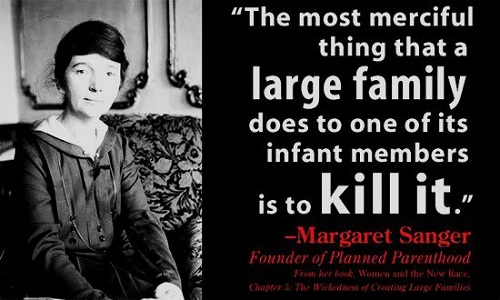 In
the US, Margaret Sanger founded the American Birth Control League,
today known as Planned Parenthood. She wrote of black people as human
weeds and devised what she called the “Negro project” to recruit black priests and community leaders in helping to encourage abortions among African-Americans. She addressed KKK rallies
and advocated the idea that all potential parents should be forced to
go before her eugenics boards to justify themselves before being granted
a “permit to breed.” She is held up as a hero of the feminist movement,
and Hillary Clinton proudly accepted the Margaret Sanger Award in 2009.
In
the US, Margaret Sanger founded the American Birth Control League,
today known as Planned Parenthood. She wrote of black people as human
weeds and devised what she called the “Negro project” to recruit black priests and community leaders in helping to encourage abortions among African-Americans. She addressed KKK rallies
and advocated the idea that all potential parents should be forced to
go before her eugenics boards to justify themselves before being granted
a “permit to breed.” She is held up as a hero of the feminist movement,
and Hillary Clinton proudly accepted the Margaret Sanger Award in 2009.
By the 1940s, the term “eugenics” had been discredited by the attempted implementation of the Nazi “master race” philosophy, itself developed at research institutions like the Kaiser Wilhelm Institute (created by the Rockefeller family), which produced some of the researchers who were later Paperclipped into the US by Dulles and the proto-CIA.
But as we will see next week, just because the name “eugenics” was no longer to be uttered in polite society does not mean it disappeared entirely. Not by a long shot . . .

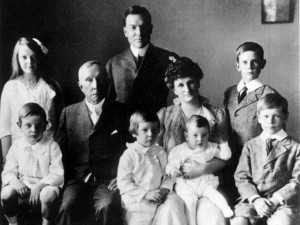
No comments:
Post a Comment